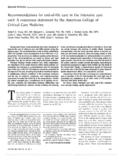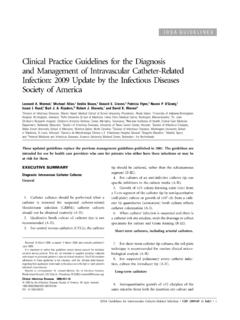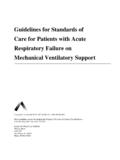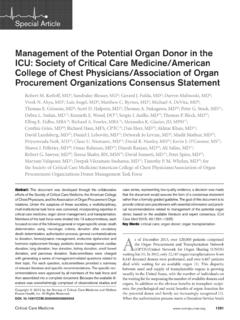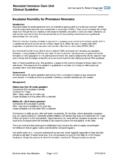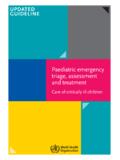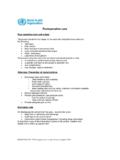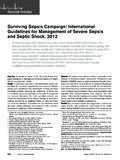Transcription of Guidelines for intensive care unit design* - …
1 1586 Crit care Med 2012 Vol. 40, No. 5special articleMost healthcare providers have little experience designing and constructing an inten-sive care unit (ICU). These ICU Design Guidelines can make the pro-cess easier and the finished project more efficient, effective, safe, and patient cen-tered. These ICU Design Guidelines are performance Guidelines rather than pre-scriptive Guidelines . A prescriptive guide-line quantifies, as in the case of minimum square footage for a patient room, whereas a performance guideline describes functions to be accommodated. As an example, the space required for a patient room and medi-cal equipment in a community hospital will be less than what may be required in a ma-jor tertiary care institution.
2 In the case of a patient room, clinical protocols and equip-ment may evolve, rendering a prescriptive guideline obsolete (1). On the other hand, the prescriptive Guidelines will describe things that must be done in the design of such space that may not be understood by the clinician, such as space for cleaning sup-plies and storage. This document proposes to describe optimum conditions rather than minimum requirements. The bibliography includes many tools that will round out the document and the process, and should be used in connection with this intent of these Guidelines is to offer a best practice approach as an alter-native to the prescriptive minimum stan-dards of The Facility Guidelines Institute (FGI) 2010 Guidelines for Design and Construction of Health care Facilities (2).
3 Other organizations, such as the National Health Service in the United Kingdom, have published Guidelines to assist in the design of new ICUs, and these should be referred to in conjunction with these per-formance Guidelines (3, 4). Optimal design Objective: To develop a guideline to help guide healthcare pro-fessionals participate effectively in the design, construction, and occupancy of a new or renovated intensive care : A group of multidisciplinary professionals, de-signers, and architects with expertise in critical care , under the direction of the American College of Critical care Medicine, met over several years, reviewed the available literature, and collated their expert opinions on recommendations for the optimal design of an intensive care : The design of a new or renovated intensive care unit is frequently a once- or twice-in-a-lifetime occurrence for most criti-cal care professionals.
4 Healthcare architects have experience in this process that most healthcare professionals do not. While there are regulatory documents, such as the Guidelines for the Design and Construction of Health care Facilities, these represent minimal Guidelines . The intent was to develop recommendations for a more optimal approach for a healing Sources and Synthesis: relevant literature was accessed and reviewed, and expert opinion was sought from the committee members and outside experts. Evidence-based architecture is just in its beginning, which made the grading of literature difficult, and so it was not attempted. The previous designs of the winners of the American Institute of Architects, American Association of Critical care Nurses, and society of Critical care Medicine intensive care unit Design Award were used as a reference.
5 Collaboratively and meeting repeatedly, both in person and by teleconference, the task force met to construct these : recommendations for the design of intensive care units, expanding on regulatory Guidelines and providing the best possible healing environment, and an efficient and cost-effective workplace. (Crit care Med 2012; 40:1586 1600)KEy WOrDs: architecture; construction; critical care medicine; design; environment; healing; intensive care unitGuidelines for intensive care unit design* Dan R. Thompson, MD, MA, FACP, FCCM (Co-Chair); D. Kirk Hamilton, FAIA, FACHA (Co-Chair); Charles D. Cadenhead, FAIA, FACHA, FCCM; Sandra M. Swoboda, RN, MS, FCCM; Stephanie M. Schwindel, MArch, LEED; Diana C. Anderson, MD, MArch; Elizabeth V. Schmitz, AIA; Arthur C. St. Andre, MD, FCCM; Donald C.
6 Axon, FAIA, FACHA ; James W. Harrell, FAIA, FACHA, LEED AP; Maurene A. Harvey, RN, MPH, MCCM; April Howard, RN, CCRN, CCRC; David C. Kaufman, MD, FCCM; Cheryl Petersen, RN, MBA, CCRN*see also p. (DRT), Surgery and Anesthesiology, Albany Medical College, Albany, NY; Associate Professor (DKH), Center for Health Systems and Design, Texas A&M University, College Station, TX; Senior Principal (CDC), WHR Architects, Inc., Houston, TX; Senior Research Coordinator ( Swoboda), Schools of Medicine and Nursing, Johns Hopkins University, Baltimore, MD ; 2010-2011 Tradewell Fellow ( Schwindel), Medical Planning Intern, & Intern Architect, WHR Architects, Inc., Houston, TX; 2008-09 Tradewell Fellow (DCA), WHR Architects, Inc, Houston, TX; 2006-2007 Tradewell Fellow (EVS), WHR Architects, Inc, Houston, TX; Director (ACS), Surgical Critical care Services, Washington Hospital Center, Washington, DC; Design Leader (JWH), Healthcare GBBN Architects, Inc.
7 , Cincinnati, OH; Educator and Consultant (MH), Glenbrook, NV; Research Coordinator (AH), Department of Medicine, Pulmonary/Critical care Medicine, Wake Forest University, Wake Forest, NC; Professor (DCK), Surgery; University of Rochester, Rochester, NY; and Cook Children s Health care System (CP), Fort Worth, TX. American College of Critical care Medicine (ACCM), which honors individuals for their achieve-ments and contributions to multidisciplinary critical care medicine, is the consultative body of the Society of Critical care Medicine (SCCM) that possesses rec-ognized epertise in the practice of critical care . The College has developed administrative Guidelines and clinical practice parameters for the critical care prac-tioner.
8 New Guidelines and practice parameters are continually developed, and current ones are systemati-cally reviewed and Anderson and Ms. Schmitz are full-time employ-ees at WHR Architects. The remaining authors have not disclosed any potential conflicts of information regarding this article, E-mail: 2012 by the Society of Critical care Medicine and Lippincott Williams & WilkinsDOI: care Med 2012 Vol. 40, No. 5 1587ideally requires knowledge of both clinical best practice and building codes (5, 6).Due to the global nature of intensive care , these Guidelines are written with the intent to be used by healthcare organiza-tions around the world. While the FGI pro-vides healthcare Guidelines that could be accepted globally, many of the standards set forth in the FGI Guidelines were born from policies and regulatory standards de-veloped in the United States (2).
9 These ICU Design Guidelines are based on the concept of form follows function and that the configuration and perfor-mance of a critical care unit should be driven by the function and place it serves. As such, these ICU Guidelines must adapt to a range of facilities, from a rural or community hospital to a teaching hospi-tal. These Guidelines are intended to ap-ply to adult medical/surgical ICUs. Other patient populations, such as pediatric, neonatal, and subspecialty, may have addi-tional or different requirements that may not be mentioned in these Guidelines (2, 7, 8). Some issues are changing so rapidly, such as information technology, they are referred to only briefly. During the design process, experts in information technology may be helpful along with the architects and engineer involved in Build a New ICU or Renovate an Old One?
10 Hospitals undertake ICU construction for many reasons: to adapt to changing pa-tient demographics or disease patterns; to upgrade or add services; and to accommo-date changes in the flow of information, materials, or patients. New construction may become cost effective when an older ICU requires expensive repairs or upkeep to remain viable, or simply ceases to func-tion well (9).Changes in performance standards and new issues in reimbursement and risk management may suggest alterations. Designing for infection control by sepa-rating patients, adding isolation facilities, adding hand hygiene stations, upgrading mechanical ventilation and filtration, re-vising provisions for disposal of human waste, or introduction of antimicrobial materials can lower infection rates and therefore morbidity and mortality, cost per case, and length of stay (10, 11).


